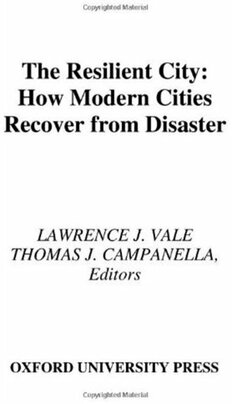
The Resilient City: How Modern Cities Recover from Disaster PDF
Preview The Resilient City: How Modern Cities Recover from Disaster
The Resilient City: How Modern Cities Recover from Disaster LAWRENCE J. VALE THOMAS J. CAMPANELLA, Editors OXFORD UNIVERSITY PRESS THE RESILIENT CITY T H E R E S I L I E N T C I T Y H O W M O D E R N C I T I E S R E C O V E R F R O M D I S A S T E R L A W R E N C E J . V A L E A N D T H O M A S J . C A M P A N E L L A EDITORS 1 2005 1 Oxford NewYork Auckland Bangkok BuenosAires CapeTown Chennai DaresSalaam Delhi HongKong Istanbul Karachi Kolkata KualaLumpur Madrid Melbourne MexicoCity Mumbai Nairobi Sa˜oPaulo Shanghai Taipei Tokyo Toronto Copyright(cid:1)2005byOxfordUniversityPress,Inc. PublishedbyOxfordUniversityPress,Inc. 198MadisonAvenue,NewYork,NewYork10016 www.oup.com OxfordisaregisteredtrademarkofOxfordUniversityPress Allrightsreserved.Nopartofthispublicationmaybereproduced, storedinaretrievalsystem,ortransmitted,inanyformorbyanymeans, electronic,mechanical,photocopying,recording,orotherwise, withoutthepriorpermissionofOxfordUniversityPress. LibraryofCongressCataloging-in-PublicationData Theresilientcity:howmoderncitiesrecoverfromdisaster/ editedbyLawrenceJ.ValeandThomasJ.Campanella. p.cm. Includesbibliographicalreferences. ISBN-13978-0-19-517584-4;978-0-19-517583-7(pbk.) ISBN0-19-517584-0;0-19-517583-2(pbk.) 1. Urbanrenewal—History. 2. Disasters—History. I. Vale,LawrenceJ.,1959– II. Campanella,ThomasJ. HT170.R462005 307.3'416'09—dc22 2004049246 “Countin’onaMiracle”byBruceSpringsteen. Copyright(cid:1)2002BruceSpringsteen.Allrightsreserved.Reprintedbypermission. 9 8 7 6 5 4 3 2 1 PrintedintheUnitedStatesofAmerica onacid-freepaper Preface ■ TherehasalreadybeenasurfeitofbooksaboutSeptember11,2001; this is not another one. But it is nonetheless a product of that fateful day, if only indirectly. As the enormity of that morning’s tragedies unfolded, the two editors of this volume wandered incredulouslybe- tween adjacent offices at the Massachusetts Institute of Technology (MIT), scrambling to gather new information about what was tran- spiring. In the days and weeks that followed, along with millions of Americans and people around the world, we struggled to make sense ofwhathadtakenplace.Oneofuslostachildhoodplaymate,aformer neighbor, fellow alumni from high school, a friend of a friend; the other lost an acquaintance and the relative of a friend, and we found thatnearlyallofourstudentswereconnectedinsomewaytoavictim of theterroristattacks. Asurbanistsandplannerswewereparticularlyshockedbythede- struction of the World Trade Center. Yes, it was the ill-lovedcolossus that Wolf von Eckhardt decried (even before it was built) as “an in- strument of urbicide,”1 but the extreme violence of 9/11 muted even theharshestcritics.Whateverweoncethoughtaboutthebuildings,we nowmournedthemandjoinedinthewide-rangingspeculationabout what they represented. For many, the terrorist attackswereanassault on the ideals of progress and modernity, the values of liberaldemoc- racy,thesanctityofhumanlife,andthecommitmenttoanopensociety that has made the United States the most free and culturally diverse nation in history. But they were also attacks on the city and all that citiesrepresent. WewereparticularlyperturbedtolearnthatMohammedAtta,re- puted organizer of the hijacker gang that crashed the planes into the WTCandthePentagon,hadstudiedarchitectureandcityplanningin Germany.HisadvisorattheTechnicalUniversityofHamburg-Harburg claimed that Atta possessed a particularly keen interest in the history ofcitiesandtownplanning.2HehadspentseveralmonthsinCairoin 1995documentingurbanrenewaleffortsneartheOldCity’sgates,and was angered by new commercial development that, he believed, “in- volved little more than knocking down a poor neighborhood to im- prove the views for tourists.”3 He feared that global capitalism was trivializing or obliterating historic landscapes in the Islamic world, a subjectheexploredinhismaster’sthesis:“TheConflictbetweenIslam andModernizationinAleppo.” Atta’s thesis subject was, ironically, one of the most resilientcities inhistory.The4,000-year-oldsettlement,locatedinpresent-daySyria, hassurvivedabewilderingarrayofdisastersthroughtheages.Across- roads of trade routes since the second millennium b.c., the city was successively ruled by the Hittites, Assyrians, Arabs, Mongols, Mame- lukes, and Ottomans. The Persians destroyed much of Aleppo in 540 a.d. It was besieged by the Crusaders in 1124 a.d. and invadedby the Mongolsin1260a.d.Ninetypercentofitspopulationwaskilledinyet another attack in 1400 a.d. It was constantly plagued by the plague, destroyed by an earthquake in the 1820s, and even invaded by mice. Yet ancient Aleppo regenerated itself again and again, and flourishes still.4 It is this spirit of resilience that inspired the present book. We wanted to know what sorts of questions others had asked in the past when confronted with disaster, and how they had managed to perse- vere. By October 2001, we began planning for a colloquium, with a booktofollow.Thecolloquium—“TheResilientCity:Trauma,Recov- ery, and Remembrance”—was held weekly during the spring of 2002 at MIT, and drew a large and enthusiastic audience. Some of this at- tendance was virtual andglobal,thankstothestaffoftheMITWorld initiative, who filmed and digitized the content for download on the Resilient City Web site (http://resilientcity.mit.edu) and also linked it totheworldwidearchitecturalcommunityofArchNet.Wethensolic- vi Preface ited additional chapters to round out the contents of this anthology. The process of organizing and producing this book was, in the end, bothascholarlyandatherapeuticexercise. Many people deserve thanks for helping make this book possible. WeareparticularlygratefulfortheinitialenthusiasmofWilliamMitch- ell,AnneWhistonSpirn,andBishSanyal,andforthegenerousfinan- cial support from the dean’s office of the School of Architecture and Planning at MIT and theMIT chancellor’soffice.Wearealsograteful for fellowship funds provided by the Helena Rubinstein Foundation, which supported the travel and research for the book’s chapters on GernikaandTangshan. WebenefitedenormouslyfromthefifteenMITstudentswhopar- ticipatedinourparallelseminarontheurbandesignpoliticsofresilient cities: Zabe Bent, Hope Fang, Jasper Goldman, Jessica Katz, Julie Kirschbaum, Aaron Koffman, Justine Minnis, Greg Morrow, Karl Munkelwitz,Keon-SooNam,SoniaParisca,JasonSchupbach,Desire´e Sideroff,ShinuSingh,andFlorianUrban. Our colleagues in the Departments of Architecture and Urban Studies and Planning at MIT and City and Regional Planning at the UniversityofNorthCarolina,ChapelHill,haveofferedperceptivecrit- icism and advice throughout this project—especially Julian Beinart, Eran Ben-Joseph, Phil Berke, Ray Burby, Phil Clay, Diane Davis,Bob Fogelson, Dennis Frenchman, Dave Godschalk, MarkJarzombek,Bill Mitchell,BishSanyal,andAnneWhistonSpirn. Laurie Everett, project manager at MIT World, helped make our colloquiumpresentationsavailableontheInternet,asdidAlexisSanal, who designedandbuilt the ResilientCityWebsite.GauravSrivastava and Melissa McMahon assisted with literature reviews, and Janice O’Brien’sorganizationalskillshelpedtokeepboththeeditorsandthe contributorsontrack.DuncanKincaidandJohnCookhelpedwiththe processing of many illustrations, and Karen Yegian assisted with nu- merousfinancialmatters.SusanFerber,oureditoratOxfordUniversity Press, deserves our special gratitude for championing this book early on and for her superb editorial attention to the many voices of this manuscript.Wearealsogratefulforadditionaleditorialassistancefrom Stacey Hamilton and Merryl Sloane. Finally, our own resilience has been carefully nurtured by the love, support, and encouragement of ourfamiliesandfriends. Preface vii Notes 1. Quoted in Michael Tomasky, “The World Trade Center:Before,During, andAfter,”NewYorkReviewofBooks,28March2002,18. 2. Liz Jackson, “A Mission to DieFor:Interview with DittmarMachule,18 October,2001,”ABCFourCorners,12November2001. 3. Jim Yardley, “A Portrait of the Terrorist,” New York Times, 10 October 2001. 4. AlexanderRussell,TheNaturalHistoryofAleppo,vol.2(London:Robin- son,1794),335–361. viii Preface
